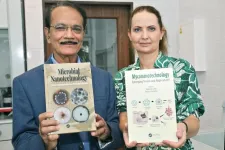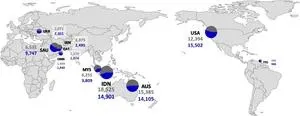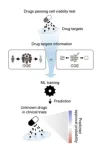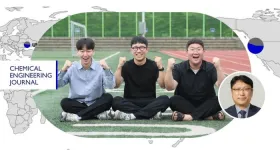(Press-News.org) Nanoparticles are tiny structures up to 100 nanometers in size. They are characterized by different physical and chemical properties and biological activity than their larger material counterparts. - When the starting material on a micro-scale with a specific surface area is broken down to nano size, i.e. into smaller particles, its surface area will increase many times. And it is the ratio of surface to volume that results in the unique properties of nanoparticles, explains Prof. Mahendra Rai from Sant Gadge Baba Amravati University in India.
Nanoparticles can be mainly organic or inorganic. Among the organic ones, we can distinguish e.g. liposomes, micelles, and dendrimers. - Liposomes are vesicles made of a phospholipid bilayer with free space inside, in which you can put, for example, a drug and precisely deliver it to the target place in the body because the liposomes will disintegrate in the acidic environment of the tumor and release the drug in it – says, prof. Patrycja Golinska from the Department of Microbiology at the Faculty of Biological and Veterinary Sciences NCU. – Among inorganic nanoparticles, we can distinguish nanoparticles of metals such as silver, gold, titanium, copper, metal oxides (e.g. zinc oxide) and semi-metals (metalloids) such as silica, selenium, and aluminium. At Nicolaus Copernicus University, we focused mainly on metal nanoparticles. So far, we have mostly biosynthesized silver and gold nanoparticles. In recent years, we have also biosynthesized nanoparticles of zinc, copper, and magnesium oxides.
Nanoparticles can be obtained in various ways, but in recent years, the so-called green synthesis (biological synthesis or biosynthesis) has attracted increasing interest in nanotechnology. - It is environmentally friendly. In biological synthesis, unlike chemical or physical synthesis, the production of nanoparticles does not use toxic compounds and does not consume large amounts of energy - informs Prof. Rai. In addition, after the production of nanoparticles in a chemical or physical way, they still need to be stabilized, i.e. "coated" with other chemical compounds, which are usually also toxic. The point is that the nanoparticles do not aggregate, i.e. do not combine with each other into structures of larger sizes and do not lose their reaction surface and thus their unique properties.
Green nanotechnology
Biologists from the Nicolaus Copernicus University in Toruń became interested in biosynthesis, i.e. the synthesis of nanoparticles by microorganisms such as fungi and bacteria, as well as by algae and plants. During the visit of Prof. Rai in Poland, scientists focused on mycosynthesis, i.e. the synthesis of nanoparticles using fungi. – As part of the project, which Prof. Rai carried out at the Nicolaus Copernicus University, we synthesized silver nanoparticles using fungi, mainly of the genus Fusarium, which infect plants, including cereals, but also from other genera like Penicillium, which develop e.g. on tangerines and lemons - says prof. Golinska. – In such production, no toxic compounds are used and no toxic waste is produced.
The advantage of fungi over other microorganisms in the synthesis of nanoparticles is that they produce a large number of various metabolites, including many proteins, including enzymes, and many of these substances can be involved in the reduction of silver ions to nanosilver.
Applications
Nanotechnology can be used in the most important areas of human life: medicine, agriculture and the packaging industry, and food storage. Nanoparticles are highly active against various microorganisms. They fight pathogenic microbes very well and inhibit their spread, which can be used to produce various surfaces and materials in hospitals, such as masks with a nanosilver filter, which were created during the COVID-19 pandemic. They are effective against bacteria that are resistant to commonly used antibiotics. Silver nanoparticles also have anti-cancer properties.
Nanomaterials are smart, they can be administered, for example, intravenously, but they work at the target site, i.e. in a cancerous tumor, and not like chemotherapy, which is distributed throughout the body at the same time destroying both abnormal and healthy cells - explains Prof. Rai. In the case of nanoparticles, we can use targeted therapy, in which the anti-cancer drug will be released only at the site of the tumor. Nanoparticles themselves can be a drug, and also a drug carrier.
In agriculture, nanotechnology is used in three aspects. The first is the early detection of plant pathogens before the first symptoms of plant disease appear. The electronic nose is a technology that we do not deal with at the moment, but thanks to the use of nanomaterials such as nanowires or nanorods of zinc oxide in this device, it detects volatile substances produced by pathogenic fungi. Other types of nanobiosensors detecting the DNA of plant pathogens can also be used, says Prof. Golinska. - Thanks to this, appropriate agrotechnical treatments can be applied before we see the symptoms of plant infestation, e.g. discoloration, raids or necrosis of leaf blades.
The second aspect is the use of a solution of nanoparticles to directly combat pathogens that have already developed on plants. Such nanoparticles usually act at much lower concentrations than chemical fungicides, so their concentration in the environment is also much lower compared to commonly used fungicides.
The third area of application of nanomaterials in agriculture is the delivery of nutrients to plants. As in medicine, nanomaterials themselves can be a nutrient or a carrier containing a nutrient that can be released in a controlled manner. When farmers use traditional fertilizers, they deliver a huge amounts of them to the fields in a short time, which plants are unable to use and a large part of them penetrates deep into the soil to groundwater and, consequently, to water reservoirs (surface water). This adversely affects the aquatic environment leading to its eutrophication. Excessive fertilization also harms soil microorganisms and leads to the so-called. "Soil fatigue", i.e. a constant imbalance in the content of nutrients, which negatively affects the size of crops. Using nanoencapsulation, i.e. placing nanoparticles that are nutrients for plants in capsules or matrices, you can apply these nutrients by foliar or soil application. The biggest advantage of this solution is the release of nutrients in a controlled, slow and constant way. This is an element of sustainable development, which is extremely important nowadays – says Prof. Rai.
Friendly fungi
Prof. Rai came to Poland for two years thanks to a scholarship he received from the Polish National Agency for Academic Exchange (NAWA). Under the proposed project, "Development of new environmentally-friendly and biologically active nanomaterials" together with a team consisting of Dr hab. Patrycja Golińska (prof. of NCU), Dr Magdalena Wypij, and PhD student Joanna Trzcińska-Wencel, dealt with the production of nanocomposites based on pullulan and silver nanoparticles (AgNPs) for combating various microorganisms. Pullulan, a natural biodegradable polymer, was biosynthesized using fungi (Aureobasidium pullulans) and combined with silver nanoparticles, produced by green synthesis using mold fungi, which I mentioned earlier - explains Prof. Golińska, and we created films, i.e. thin and flexible foils, encrusted with silver nanoparticles. We tested these films, for example, to combat pathogens responsible for wound infections or those that develop in food, such as Listeria monocytogenes or Salmonella sp., i.e. de facto to extend the shelf life of food.
Pullulan incorporated with silver nanoparticles presents beneficial properties and therefore could be used, for example, in the production of food packaging or dressings which accelerate the healing of wounds, protecting them against the development of infection. - When we have more extensive wounds, e.g. burns, they are highly exposed to the development of infection - explains Prof. Golińska - Securing such a place with a biodegradable polymer with an agent inhibiting the development of pathogens will significantly accelerate wound healing.
The team intends to patent a method for obtaining pullulan-based nanocomposites and releasing nanoparticles from the film. Morover, Prof. Rai and Prof. Golińska edited three important books: "Microbial Nanotechnology", "Myconanotechnology: emerging trends and applications" and "Mycosynthesis of Nanomaterials: Perspectives and Challenges" published by the prestigious publishing house CRC Press/Taylor and Francis Group. “We hope that these books will open up new possibilities in the field of environmentally friendly green nanomaterials,” says Prof. Rai.
In addition, two research papers were published during the professor's visit, namely “Biogenic nanosilver bearing antimicrobial and antibiofilm activities and its potential for application in agriculture and industry” (https://doi.org/10.3389/fmicb.2023.1125685) and “Superior in vivo wound-healing activity of mycosynthesized silver nanogel on different wound models in rat” (https://doi.org/10.3389/fmicb.2022.881404), and another two "Biofabrication of novel silver and zinc oxide nanoparticles from Fusarium solani IOR 825 and their potential application in agriculture as biocontrol agents of phytopathogens, and seed germination and seedling growth promoters" (https://doi.org/10.3389/fchem.2023.1235437) and “Pullulan-based films impregnated with silver nanoparticles from Fusarium culmorum strain JTW1 for potential applications in food industry and medicine” (https://doi.org/10.3389/fbioe.2023.1241739) were published just after Prof. Rai left from Poland. Another measurable effect of the cooperation of Prof. Rai with Prof. Golińska will be a visit to the Nicolaus Copernicus University of Dr. Aniketkumar K. Gade who received the grant from National Science Centre of Poland in the Polonez Bis 2 call, under which he will be employed for 24 months as an associate professor and come to Toruń in October. He will also implement a project related to the application of nanotechnology in agriculture. He will produce bionanoparticles encapsulated with casein, which will be used as fertilizer in the future.
The goal of the research team working at Nicolaus Copernicus University is to create nanoformulations used as nanofertilizers and agents for controlling the development of plant pathogens, which can be widely used in agriculture to replace chemical fertilizers and plant protection products currently used in a large amount. – This is to limit the use of chemicals in agriculture, lead to sustainable development and mitigate the effects of the changing climate – says Prof. Rai.
END
The green power of fungi
2023-09-08
ELSE PRESS RELEASES FROM THIS DATE:
Liver cancer and severe liver disease more common if a close relative has fatty liver disease
2023-09-08
Close relatives of people with metabolic-associated fatty liver disease have a higher risk of developing liver cancer and dying from liver-related diseases, according to a national study from Karolinska Institutet in Sweden published in The Journal of Hepatology. This means that family members could also benefit from the lifestyle advice that is currently only given to patients, the researchers conclude.
People with metabolic-associated fatty liver disease (MASLD, formerly known as NAFLD – see fact box) have an elevated risk of developing and dying from liver cancer. MASLD is now the main reason why the number of people developing liver cancer ...
Bees struggle to find flowers because of air pollution
2023-09-08
A new study has found that air pollution is preventing pollinators finding flowers because it degrades the scent.
A research team comprising the UK Centre for Ecology & Hydrology (UKCEH) and the Universities of Birmingham, Reading, Surrey and Southern Queensland, found that ozone substantially changes the size and scent of floral odour plumes given off by flowers, and that it reduced honeybees' ability to recognise odours by up to 90% from just a few metres away.
Ground-level ozone typically forms when nitrogen oxide emissions from vehicles and industrial processes react with volatile organic compounds emitted from vegetation ...
Study shows food from tobacco-owned brands more 'hyperpalatable' than competitor's food
2023-09-08
LAWRENCE — Many of us know all too well the addictive nature of many foods marketed in the United States — most call it “junk food.” In fact, this kind of salty, sweet and high-fat fare makes up the lion’s share of what’s marketed to Americans.
Researchers employ a more scholarly term for food items featuring purposely tempting combinations of salts, fats and sugars: They’re “hyperpalatable.”
Now, an investigator at the University of Kansas has conducted research showing food brands owned by tobacco ...
What do neurons, fireflies and dancing the Nutbush have in common?
2023-09-08
Computer scientists and mathematicians working in complex systems at the University of Sydney and the Max Planck Institute for Mathematics in the Sciences in Germany have developed new methods to describe what many of us take for granted – how easy, or hard, it can be to fall in and out of sync.
Synchronised phenomena are all around us, whether it is human clapping and dancing, or the way fireflies flash, or how our neurons and heart cells interact. However, it is something not fully understood in engineering and science.
Associate Professor Joseph Lizier, expert in complex systems at the University of Sydney, said: “We know ...
Drug approvals in clinical trials were correlated with the cells/humans discrepancy in gene perturbation effects
2023-09-08
Developing new drugs is paramount in discovering innovative treatments and preventing diseases. This is vital not only for advancing medicine but also for the overall health and well-being of humanity. Yet, even when drugs demonstrate safety and efficacy in cell and animal models, they frequently encounter hurdles in clinical trials on human.
A single setback for a drug during clinical trials, which involves diverse population groups, can result in significant economic losses. To address this, it is imperative to understand why certain drugs, despite passing the preclinical stages, falter during clinical ...
Unveiling the causes of the 1931 Yangtze River Deluge
2023-09-08
In the summer of 1931, an unprecedented calamity unfolded along the Yangtze River basin in eastern China - the 1931 Yangtze River flood, known as one of history's deadliest natural disasters. This cataclysmic event submerged a staggering 180,000 km2, affected 25 million lives, and tragically claimed over 2 million lives.
Despite its immense societal impact, the origins of this monumental flood have remained largely unexplored, a challenge compounded by the scarcity of historical records and pre-1950s meteorological data in China. Recent access to crucial historical datasets has, however, unlocked the ability to investigate the 1931 Yangtze River flood.
A recent study published ...
Physical activity boosting resources support classroom performance
2023-09-08
DALLAS, September 8, 2023 — This back to school season the American Heart Association and the National Football League (NFL), in collaboration with its 32 NFL clubs, are offering students exciting ways to move more with NFL PLAY 60™. Physical activity is important as students return to the classroom. According to the U.S. Department of Health and Human Services’ 2018 Physical Activity Guidelines for Americans, active kids learn better, focus more, think more clearly, react to stress more calmly, and perform and behave better in the classroom[1].
The ...
New study highlights feasibility and optimization of ammonia-based power generation for carbon neutrality
2023-09-08
Ammonia is emerging as a promising energy source to achieve carbon neutrality due to its inherent carbon-free nature. A recent study, led by Professor Hankwon Lim in the School of Energy and Chemical Engineering and the Graduate School of Carbon Neutrality at UNIST, has evaluated the feasibility of ammonia-based power generation through techno-economic and carbon footprint analyses. The research focuses on an integrated system combining ammonia decomposition and phosphoric acid fuel cells.
The study, conducted using a commercial process simulator, unveils significant findings regarding the efficiency and economic viability of utilizing ammonia ...
UTSA researchers explain plant’s medicinal power against COVID and glioblastoma
2023-09-08
Vibrant green leaves sprout from tall fragrant plants sitting neatly in two rows of terracotta pots in Valerie Sponsel’s UTSA biology laboratory. One floor just above her is the chemistry lab of Francis Yoshimoto, who is extracting the plant’s leaves for medicinal compounds. Soon, the researchers will meet with UTSA researcher Annie Lin, who will test the extracted compounds on cancer cells.
The plant is Artemisia annua, or Sweet Annie, and it contains medicinal compounds. UTSA researchers are studying the plant to understand the bioactive properties of one of these compounds, Arteannuin B, in cancer cells and COVID, the ...
Benchtop NMR spectroscopy can accurately analyse pyrolysis oils
2023-09-08
Benchtop NMR spectroscopy can accurately analyse pyrolysis oils
Pyrolysis bio-oils have the potential to be widely used as alternative fuels but are very complex to analyse
Cheaper, simpler, low-field, or ‘benchtop’, NMR spectrometers were able to accurately quantify key oxygen-containing components of pyrolysis bio-oils for the first time
More accessible analysis could help develop the potential of bio-oils as an alternative to fossil fuels
EMBARGOED UNTIL FRIDAY 8TH SEPTEMBER at 9am UK time 2023 | Birmingham, UK
A team of researchers at Aston University ...







